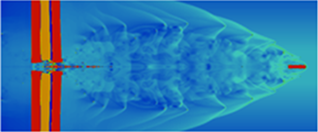Sandia’s Computational Shock & Multiphysics Department 01443 provides unique, state-of-the-art modeling and simulation capabilities using a variety of multiphysics discretization technologies to simulate high strain rate, magnetohydrodynamic, electromechanic and high energy density physics phenomena for the U.S. defense and energy programs. To accomplish this objective, we conduct an active program of research and development in computational shock physics and methods, produce high-performance application codes that address relevant issues important to the DOE, DoD, DHS, and other U.S. Government agencies, and support production use of our codes by our principal customers.
Computational Physical Simulation

The CCR and Sandia have a long and distinguished history of leadership in computational science and engineering, including massively parallel computation, uncertainty quantification, mathematical optimization, scalable solvers, software toolkits, and scientific software engineering, to name a few. The CCR stewards, leverages, and extends these capabilities to remain responsive to Sandia’s immediate mission needs. At the same time, CCR anticipates and pursues mathematical and computational technologies that may have an impact on future mission needs.
Focus Areas
We perform research and development of advanced algorithms for engineering-based optimization. This includes engineering design optimization, model calibration (i.e., parameter estimation), and material identification (or inversion). Often, the problems we address have equality constraints given by solutions to partial differential equations. We implement these algorithms in our flagship software tools DAKOTA (http://dakota.sandia.gov) and Trilinos (https://trilinos.github.io/). Our optimization capabilities may be used on their own or as components within advanced strategies such as surrogate-based optimization, mixed integer nonlinear programming, or optimization under uncertainty.
Multiphysics Simulation Technologies develops advanced or novel simulation methods and application software designed for use on high-performance computing platforms to solve currently intractable problems of national importance. Current strategic thrusts include development and application of peridynamics and gradient-free methods for material failure, fracture, and fragmentation and development of new integrated capabilities in support of nuclear energy, including reactor performance and safety and used nuclear fuel storage and disposal. Core areas of competency include PDE solution methods, multiscale techniques, multiphysics coupling, embedded uncertainty quantification, constitutive modeling, and code development.
Applied mathematics and numerical analysis provides a key foundation to Sandia’s success in applying advanced computing to solve national-scale problems. Such work includes development of new numerical discretizations that are provably stable and convergent for multi-physics problems as well as algorithms and tools for mathematical optimization in the presence of uncertainty that enable critical decisions to be made based on the results of computer simulation. In each case, these methods are developed with a keen awareness of the underlying mathematics and are applied to a wide range of energy, geoscience, climate and national security applications.
Uncertainty Quantification (UQ) is a growing area of importance for quantifying confidence in computational engineering simulations. Our activities in this area include fundamental algorithm research, implementation of those algorithms into our flagship software tools DAKOTA (http://dakota.sandia.gov) and Trilinos (http://trilinos.sandia.gov), and deployment of those tools to mission-critical application teams within Sandia as well as other partners throughout the country. A major focus of the technical R&D is on improving robustness, computational efficiency, and scalability for problems with high random dimensions, multi-scale and coupled multi-physics applications, and problems with difficult-to-model physics such as nonlinearities and discontinuities.
Verification and Validation (V&V) are important technologies for enabling a science-basis for computational engineering predictions. Our activities include development of new methodologies and workflows for code verification, solution verification, and validation, in support of engineering analysis. This work requires close partnership with other Sandia organizations. We also work across organizations to develop and apply predictive maturity assessment methodologies.